
The History of the Akha-Church
The
history of the Akha church is fascinating. To understand it, it is important to
know the religious background of these people.
The Akha/Hani
religion is a combination of animism and ancestor worship. Their worldview is
completely colored by their animistic belief, thus even the cultivation of rice
is bound up with myths and rituals and must be done the “Akha/Hani way”.
The Akha/Hani
people also have an understanding of a great world-creating divinity. All
sicknesses are under the control of this
spirit, therefore, sacrifices must be made continually in an attempt to gain its
favor. Every village has two spirit gates. The gates are situated at the village
entrance and exit to mark the kingdom area of the spirit and its people. The
villagers build new gates every year and dedicate them to the spirits with many
sacrifices. The Akha/Hani people also are heavily involved in ancestor worship
and show a remarkable knowledge of their ancestral past;most Akha/Hani men are
able to recite over 60 names of their male ancestors.
Veneration
of the ancestors is important because it is believed that the ancestors can
bestow blessings on those still living. The ancestral altar kept in each home is
well maintained. Nine times a year, on special occasions such as New Year and
the beginning of the rice harvest, sacrifices are offered to the ancestors and
to the demons whose paraphernalia also clutters the ancestor altar.
 |
When
the first missionaries came to North-Thailand they found that the Akha
were very poor, despised and looked down upon by the North Thailand
population. The death rate among children was high, many people were
undernourished and some of them sick with no health care in their
neighborhood. |
 |
The spirit gate at the entrance and exit of every village showed clearly that the Akha were under the slavery of demon- and ancestor worship. Fear that the spirits might cause sicknesses or that the ancestors would withhold their blessing ruled the everyday life of the Akha. |
 |
The poverty was due to the fact, that most of the older men were addicted to opium and everything valuable had to be sold to be able to buy the opium. |
 |
1940
Up
in Myanmar a dedicted Karen evangelist brought the Good News to the Akha
around 1940. A young boy opened his heart to Jesus and was baptised when
he was 13. This Karen evangelist was his friend, his model and his
teacher. He often went with him on evangelistic trips and when
persecution came and Salalo
Tu Jaw had to hide in the forest, the boy helped providing food for him.
So he learned that to follow Jesus can also mean hardship.
|
 |
1947 Paul and Eliane Lewis have lived and worked amongst tribal people (primarily Lahu and Akha) since 1947, first in Kentgtung State, Burma until 1966 and since 1968 in northern Thailand. They are missionaries of the Board of International Ministries of the American Baptist Churches, and have studied linguistics and anthropology. While working with tribal groups in the areas of literature production, primary health care, family planning, education and craft marketing, thy have observed and studied the cultures of the Karen, Hmong, Mien, Lahu, Akha and Lisu.
|
 |
The
boy grew up and got married. One day his father in law came back from a
shopping trip to the border town Maesai in Thailand and told his
son-in-law that he had met a white missionary who was trying to reach
the Akha with the Good News of the Jesus-way. They felt, that he needed
help and with the blessing of their family and pastor Tu Jaw, they
decided to move down to Thailand to help this foreign missionary.
|
 |
1955 Peter
Nightingale from Australia had met Jean
from England while studying Thai They
fell in love and got married in
l955. They got a warm welcome from the christian church in Nambokaw
where they could live at the bottom of the hills where many Akha lived. Jean,
being a nurse and midwife helped many people with simple medicines.
Peter made trips into the hills and tried to learn the Akha-language. He
got no permission to live in an Akha village.
|
 |
When
Yaju with his wife Meechu found the Nightingales in Nambokaw and offered
to help with the evangelistic work, the joy and encouragement was great,
although it was not easy for Yaju to accept OMF rules, that after the
exodus from China there would be no more paid evangelists from among the
Nationals. They would have to support themselves. Yaju humbly accepted
this and moved up the Kayeh hills where he lived outside the spirit gate
and made his own fields to support his little family. Peter
Nightingale supported Yaju by visiting him every Sunday and holding a
service with the family. Yaju tried to be a testimony among the
villagers but it took 4 years, until he saw the first-fruit of his
labour: Two families decided to leave the demon-way and follow the
Jesus-way. They could not live within the spirit-gate anymore as they
would no longer sacrifice to the demons. And so they were driven out of
the village with much derision and mockery. Nobody believed that a small
village of 3 families could survive in the forest. |
|
It was 1962 that
Peter and Ruth Wyss were designated to work with the Akha people and
they were very happy to meet the two new christians and Yaju at
Nightingales place in Nambokaw. |
|
 |
The younger brother of A Tsa also decided that he would leave the
demon-way and joined his half-brother at the small christian village. |
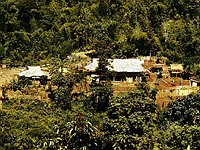 |
Now
the time had come when the missionary could finally move into an Akha
village and with the generous help of the Nambokaw-christians an Akha
house was put up. It was a bit bigger than the others as it also served
as meeting place for the small christian community. |
 |
Nightingales furlough was due in August l962 and so the Wysses were asked to move up the hill to be an encouragement to the small group of new christians. They did not know the language yet, but the Akha christians were good teachers and wanted them to learn their language as quickly as possible. |
 |
Besides
the language, every missionary also has to make himself familiar with
customs and culture of the people he wants to win for Christ, so that he
can understand the way of thinking and their reaction to things. |
 |
The
small christian community met every evening for fellowship, singing and
teaching from the word of God. Sala Yaju was the faithful leader of the
group and with his gift of music, he was a great help to teach singing,
something which the Akha love very much. |
 |
A small bamboo chapel was built and every Sunday Sala Yaju taught the Word of God and led the christians in their prayermeetings. |
 |
Whenever
the fieldwork allowed it, the young christians went out to visit their
relatives and friends in other villages to tell them about their new
found faith. Gospel recordings were a great help and they could be left
in the village. Years later it was evident that these recordings which
could be listened to again and again had a great impact on the people in
villages far off the road.
|
 |
Posters
also helped to explain the Good News of Jesus to interested listeners. |
 |
1963
But
growth was very slow. Little did the missionaries realize at that time,
that the christians were being watched very carefully all the time. What
would happen, if you did not bring sacrifices to the demons any more?
Would the fields still yield crops? Would the people still have children.
God knew and during that first year in every family, including the
missionaries , a baby boy was born. This picture shows the christian
community in l963 in Kayeh. |
 |
1968 The
christian men felt, that there was not enough room for real growth in
Kayeh. So
they began looking around for another site for their christian village.
In l968 they found a new place at the foot of Elephant mountain. Again
there was a christian church at the foot of the mountains and the pastor
helped them find the place and welcomed them to come and live in the
hills above the village Hueisan.
|
| New Testament Printing
1968 |
The New Testament was printed in Akha-language. |
 |
The
village Hueisan or in Englisch called Elephant Valley in l968. |
 |
The Akha christian leaders asked Peter and Ruth Wyss to come to their new village and help them. When they put up the missionaries house, they added a large room to teach children and the new believers. |
 |
The
christian community in Elephant Valley which now began to grow steadily.
|
 |
Peter and Jean Nightingale were working in a new christian village behind Elephant Mountain, teaching the new believers. From time to time the two couples met to discuss the future of there service amongst the Akha churches in the home of the superintendent Peter Wyss. |
 |
The
leaders realized that it was of great importance to teach the young
people in the Word of God and how
to bring the Good News to the villagers who had never heard before. As
the existent Bible Schools were all using the Thai language which was
very difficult to follow for the YP who had never been able to go to
school, it was decided to have their own month long Bible School in the
Akha language at Phayao during School holidays.
|
 |
Sala
Yaju and Sala Aju the two pastors of the first christian community were
very eager to study the Word of God and to get help for their sermon
preparation. |
 |
One
great problem arose when the government decided that no more slash and
burn method was allowed for
the hill farmers.
|

|
The
hilltribe farmers tried to use the same fields again and used the hoe to
get rid of the weeds. But when the monsoon rains came the danger of
erosion and floods was evident. What could be done to help the Akha in
this situation? |
 |
Peter
Wyss had studied horticulture and he wondered if terraced fields could
be the answer. He also had in mind, that many young people in his
country should be given a chance to see the challenge of missionary work.
He organized work parties to help dig a long ditch in order to water
terraced hill fields and give the Akha a chance to see how it could be
done. |
 |
1972
Freddy Gasser
together with Atsa, the headman of Elephant-Valley.
|
 |
1973
20
young people came during the summer of l973 and they worked ever so hard
to give the Akha an example of what could be done instead of slash and
burn method. |
 |
Ruth Stamm took part in one of the work-parties
|
 |
1974 in April l974
Ruth and Freddy were married in Switzerland
and came out together to give agricultural help to the tribal people in
Norththailand.
|
 |
Freddy Gasser
|
 |
Simple methods had to be used. It was very hard work and methods used hundreds of years are not easily changed. Since the farmers livelihood depends on the success of new methods, he has to be very sure that new methods will work. |
 |
Terraced
rice fields above Elephant valley was the outcome of a lot of hard work
It showed that this was one of many solutions to the problem of slash
and burn.
|
 |
Terraced rice fields need water. Freddy Gasser gives instructions how to
bring the water into the fields.
|
 |
1975
Many Akha people in the Maechan area began to show interest to turn to the Jesus way and by 1975 there were 7 christian villages. How grateful we were to have those young people at Elephant Valley who had studied the Word of God and now were willing to go and live in one of these new christian villages to teach the Word of God and literacy to these new christians.Maeha was one of those villages and the headman was very eager to get help and have missionaries come and live in his place.
|
 |
May
Wilson was a new worker, just finished with her Thai studies and eager
to live in an Akha village to learn the Akha language. Robert Mosimann
was one of the work-parties of l974 and felt called to go to Bible
School and then come back to work with the Akha. They were married in
l986. |
 |
1977 January
l977 Word came from Mala village near Maechan, that a number of people
wanted to be baptized and so another christian village was waiting
for teaching.
|
 |
March 1977
In
March l977 word came from Maeha that they had gathered all the necessary
material to put up a house for May and Joyce. A visitor from Switzerland,
Samuel Schweitzer, was very eager to go along with Peter to see how an
Akha house was put up in 2 days. On
March 16 they were expected back so that Sami could fly back to his
family in Switzerland the next day. They never arrived in Maechan. When
Ruth with friends Ann Burgess and Joyce Parkin went to look for them the
next day they found them both shot in the jungle about 20 min walk from
the village they had left the evening before.
|
 |
It was a great shock to the whole christian community in North-Thailand
and many friends gathered around to help and to take part in the funeral.
Peter Wyss was buried in the christian cemetry in Denha near Chiangrai. |
 |
Peter
Nightingale had to go home because of cancer and now Peter Wyss was dead
.The Akha said later: We felt like children who had lost their fathers.
But then we realized that now we had to grow up and be leaders for
others.
|
 |
1987
In l987 The Akha
church-leaders felt, that they would like to celebrate the silver
Jubilee: 25 years since the
first two couples had trusted in the living God. All missionaries who
had worked with the Akha during these past 25 years were also invited
for the festival. A new gate stood at the entrance with the text: Come
to me and I will give you rest – all of you who work so hard beneath a
heavy yoke. Matth. ll, 28. More Pictures under:
Jubilee 1987
|
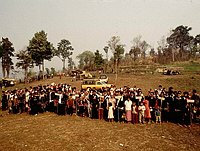 |
It was a great joy to the old missionaries who had to leave the field not by choice but by circumstances, to see how many Akha had come to the Jubilee. And they were just representatives of their respective villages. 22 Jesus villages were represented and the first missionaries rejoiced in the goodness of the Lord. |
| What
a joy to meet old friends, to sing praises together, to listen to all
the many choirs and to the testimonies and the teaching. The first two
families were still there and had faithfully followed the Lord all these
25 years. Sala Yaju and his wife had faithfully witnessed, taught and
evangelized through almost 30 years and could now see the fruit of their
labor.
|
|
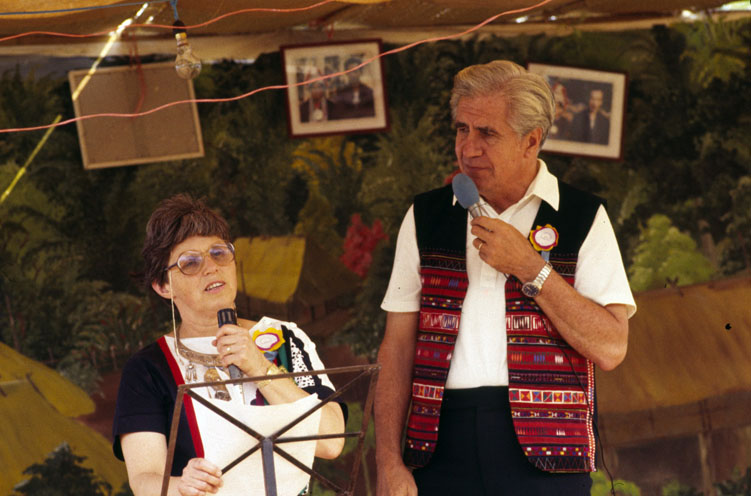 |
Paul Lewis translating Ruth |
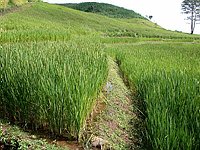 |
Fritz
Fankhauser, now the 2nd husband of Ruth Wyss who had been at
that work-party in l973 went up to the valley where they had worked so
hard to dig that long ditch to water the terraced hill fields. How
wonderful, the whole valley was planted with rice. The labor of those
young people had not been in vain. The fruit was growing.
|
 |
|
 |
The
Centre was opened in l992 and mainly used for leadership training and
for Conferences. The Swiss missionary Robert Mosimann was the main
initiator of this centre and also played a big part in constructing it.
Unfortunately the Mosimann family had to return to Switzerland
because of health problems.
|
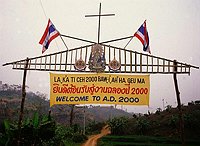
|
2000
Obviously the Akha love to celebrate. So they felt that the year 2000 should also be celebrated with a large conference. More Pictures under: Conference 2000 |
| Old Testament Printing 2000 | The Old Testament was finished and printed
|

|
Many came from far and
wide, nowadays by truck and no longer on foot.
And they had a blessed and wonderful time together. The Lord let
them see a miracle when in answer to prayer a great storm suddenly was
calmed. It rained and blasted all around Elephant mountain, but at the
conference site there was calm and no rain.
|
 |
How
grateful were all the many people who camped along the hillside, that
there was no rain. What a good God we have! |
 |
The
program was enriched by many schoolchildren on holidays who sang some of
the songs they had learnt at school. The many visitors enjoyed the
choirs, the testimonies and the teaching. |
 |
No
more slash and burn method. The Akha have adapted their farming to new
methods: fruit trees in the lower hills, cash crops in order to buy rice
on the market.
|
 |
Pine
apple fields on the plains help the farmers to make a new livelihood.
|
 |
A big dorm for the many children who want to go to school and need a place to stay during the week was erected at the Akha-Centre.
More about the Akha church centre in Akha-Centre Ladys conference in the Akha-Centre
|
 |
|
 |
2008 In
Banana village a second Discipleship training centre was
built. The younger missionaries Puii and Asholi (Daugther and son in law
of Zauva and Awi), who live in Maechan, are spending their weekends in
this village and are training the young people. Puii has started to
train Sunday School teachers in the Thai language, as the children who
go to School have to use the Thai language there. |
 |
Zauva and Sala Abyeh (son of Lawpa and Buja) have started Akha Radio work. This is a new Milestone in the Akha ministry. The first message was broadcasted on the 27th October 2008. Praise God His loving Gospel will be broadcasted to all Akha/Hani people every evening.
|
 |
ACT churches have renovated Peter Wyss's tombstone. They covered all sides with tiles, renewed the inscription and added Peters picture to it. The villagers have contributed the money for this project.
|
|
|